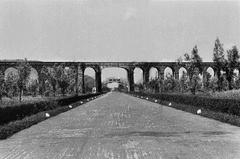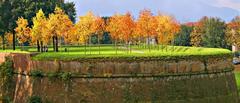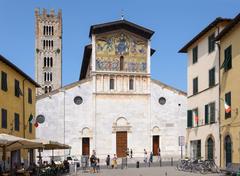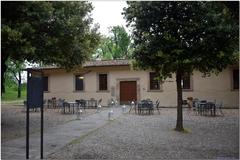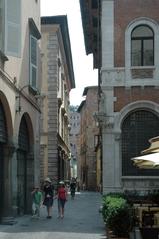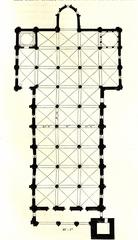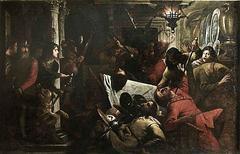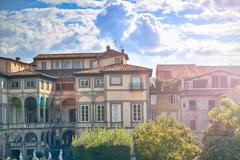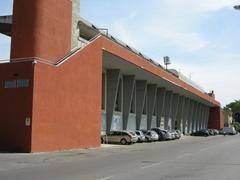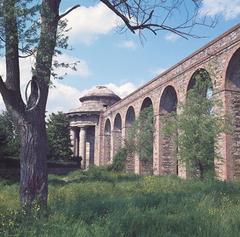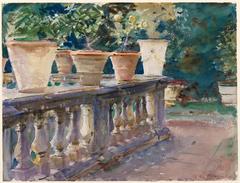City Walls of Lucca: Visiting Hours, Tickets, and Historical Significance
Date: 03/07/2025
Introduction
Nestled in the heart of Tuscany, the City Walls of Lucca (Le Mura di Lucca) stand as a testament to the city’s rich history and enduring spirit. These Renaissance fortifications, among the best-preserved in Europe, seamlessly blend centuries-old military engineering with vibrant urban life. Encircling Lucca’s historic center, the walls offer not only a journey through time but also a dynamic public space for walking, cycling, and cultural events. This guide provides a detailed overview of the walls’ history, architectural features, visiting hours, ticketing, accessibility, and insider tips—ensuring every visitor can make the most of this iconic Tuscan landmark.
Historical Overview
Roman and Medieval Foundations
Lucca’s city walls have roots reaching back to the Roman era, around 200 AD, when initial fortifications protected this strategic settlement. Over time, as Lucca flourished as an independent city-state, the need for stronger defenses grew. Medieval expansions bolstered the city’s protection, yet advances in warfare soon rendered these early walls obsolete (barrykissane.com).
Renaissance Construction and Engineering
The walls we see today were constructed between 1504 and the late 17th century by the Republic of Lucca, in response to threats from powerful neighbors like Florence and Modena (visititaly.eu). Spanning 4.2 kilometers in circumference, the walls are notable for their earthwork core—an innovative design to withstand artillery fire. Their immense thickness (up to 30 meters at the base) and height (12 meters) represent the pinnacle of Renaissance military engineering, making them the second-largest intact wall system in Europe after Nicosia, Cyprus.
Architectural Features
Lucca’s walls feature 11 bastions, 12 curtain walls, and 6 monumental gates, each with distinct architectural and historical character:
- Porta San Pietro (1566): The oldest Renaissance gate, on the southern side.
- Porta Santa Maria (1593): Northernmost gate, also known as Porta Borgo Giannotti.
- Porta San Donato (1629): Western gate, recognized for its decorative elements.
- Porta Elisa (1811): Commissioned by Elisa Baciocchi during the Napoleonic era.
- Porta Sant’Anna (Porta Vittorio Emanuele) (early 20th century): Built to accommodate modern traffic.
- Porta San Jacopo (1931): The most recent addition (visititaly.eu).
Visiting the City Walls: Hours, Tickets, and Accessibility
Visiting Hours
The City Walls of Lucca are open 24 hours a day, seven days a week. There is no admission fee or ticket required to access the walls, making them one of Italy’s most accessible major landmarks. For the best experience—especially for panoramic views and photos—visit during daylight hours (Audiala).
Tickets and Entry Fees
- General Access: Free, no ticket required.
- Guided Tours and Special Attractions: Some guided walking or cycling tours, as well as access to casemates (underground tunnels), may require a fee. Check the official Lucca tourism website for current details.
Accessibility
The promenade atop the walls is wide, flat, and mostly paved, making it suitable for wheelchairs, strollers, and visitors of all ages. Ramps and elevators at key gates ensure accessibility. For specific needs, consult local tourist offices.
Experiences on the City Walls
Walking, Jogging, and Cycling
The 4.2-kilometer circuit is ideal for a leisurely walk (1–1.5 hours), jog, or bike ride. Bike rentals are available near main gates like Porta San Pietro (Antica Bifore). Cyclists should yield to pedestrians, and all users are encouraged to respect the historical structure and natural surroundings.
Bastions, Gates, and Panoramic Views
Notable bastions—like San Martino and San Pietro—provide scenic rest areas and playgrounds, while gates such as Porta Santa Maria and Porta San Pietro serve as historical landmarks and convenient entry points. From atop the walls, enjoy sweeping views of Lucca’s medieval skyline, iconic towers like the Guinigi Tower (with its rooftop garden), and the rolling Tuscan countryside (Why This Place).
Picnics, Leisure, and Events
The walls are lined with mature trees and landscaped lawns, making them perfect for picnics or quiet relaxation. Throughout the year, the walls host concerts, open-air markets, and major events like the Lucca Summer Festival and Lucca Comics & Games (EventsLiker). During such events, food stalls and restrooms are set up at key points.
Changing Role: From Fortress to Public Park
Remarkably, Lucca’s walls never faced a full-scale siege and have remained largely intact. By the 19th century, under Duchess Maria Luisa of Bourbon, their military function was replaced by a new role as a public park—Passeggiata delle Mura—featuring tree-lined avenues, gardens, and recreation areas (turismo.lucca.it). Today, they serve as a vibrant social and cultural hub, integrating the city’s past with its present.
Social and Cultural Significance
The walls are a symbol of Lucca’s independence and resilience (I Am Italian). Locals and visitors use the promenade for daily walks, exercise, and gatherings. Many former military structures have been repurposed as cafés, museums, and community venues. The walls’ integration into everyday life makes them a living monument, alive with activity and tradition (Europa Tips).
Practical Travel Tips
- Best Time to Visit: Spring and autumn for milder weather and fewer crowds.
- Footwear: Comfortable shoes for walking or cycling.
- Photography: Golden hour (after sunrise, before sunset) offers ideal lighting.
- Guided Tours: Book in advance, especially during festivals or high season.
- Facilities: Public restrooms and benches are available; drinking fountains operate in warmer months.
- Nearby Attractions: Easily combine your visit with the Guinigi Tower, Torre delle Ore, Piazza dell’Anfiteatro, and Lucca Cathedral (Why This Place).
Events and Activities
The walls host major events such as the Lucca Summer Festival, transforming the ramparts into an open-air stage for international music acts (EventsLiker). Other highlights include artisan markets, art exhibitions, and community runs like the weekly parkrun. For up-to-date schedules, check official tourism sites.
Transportation and Parking
Lucca is accessible by train (about 75 minutes from Florence) (FlorenceTips), regional buses, and car. Parking is available outside the walls; during festivals, book in advance (EventsLiker). The historic center and walls are pedestrian and bike zones only.
Accommodation
Staying inside the walls immerses you in Lucca’s ambiance and offers easy access to attractions. From luxury hotels to boutique B&Bs, there’s a range of options (Antica Bifore). Book early for stays during popular events.
Frequently Asked Questions (FAQ)
Q: What are the City Walls of Lucca opening hours?
A: The walls are open 24/7 with free access.
Q: Is there an entrance fee or ticket required?
A: No, general access is free. Guided tours or special attractions may have a fee.
Q: Are the walls accessible for wheelchairs and strollers?
A: Yes, ramps and elevators ensure accessibility.
Q: Can I cycle on the walls?
A: Yes, cycling is permitted; rentals are available near major gates.
Q: Are guided tours available?
A: Yes, walking and cycling tours—with historical commentary and local insights—can be booked through visitor centers.
Visual Media and Resources
Enhance your planning with virtual tours, interactive maps, and high-quality images available on the official Lucca tourism site. Alt tags like “City Walls of Lucca panoramic view” and “Walking path atop Lucca’s historic walls” are suggested for accessibility.
Summary
The City Walls of Lucca embody a living heritage—balancing Renaissance innovation with contemporary community life. As a symbol of the city’s independence and adaptability, the walls invite exploration, relaxation, and cultural engagement. With free, round-the-clock access, excellent facilities, and a lively events calendar, they are a must-see for any visitor to Tuscany. Enhance your experience by downloading the Audiala app for audio guides and insider tips, and follow local tourism platforms for the latest updates.
References
- Lucca City Walls: Visiting Hours, Tickets, and Historical Guide to Lucca’s Iconic Fortifications, 2025, Barry Kissane
- History of the Walls of Lucca – From Defensive Stronghold to Tourist Attraction, Visit Italy
- Discovering the City Walls of Lucca: Visiting Hours, Tickets, and Historical Insights, Nomads Travel Guide
- The Medieval Fortifications of Lucca: Walls That Tell Stories, I Am Italian
- City Walls of Lucca: Visiting Hours, Tickets, and Exploring Lucca’s Historic Fortifications, The Crazy Tourist
- City Walls of Lucca Visiting Hours, Tickets, and Travel Guide to Lucca Historical Sites, Audiala
- Ultimate Guide to Lucca Summer Festival 2025, EventsLiker
- Exploring Lucca and its Medieval Walls, Antica Bifore
- Travel Guide to Lucca, Italy, Why This Place
